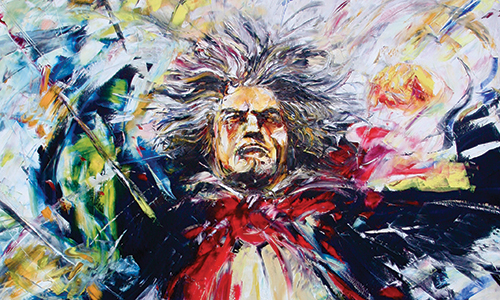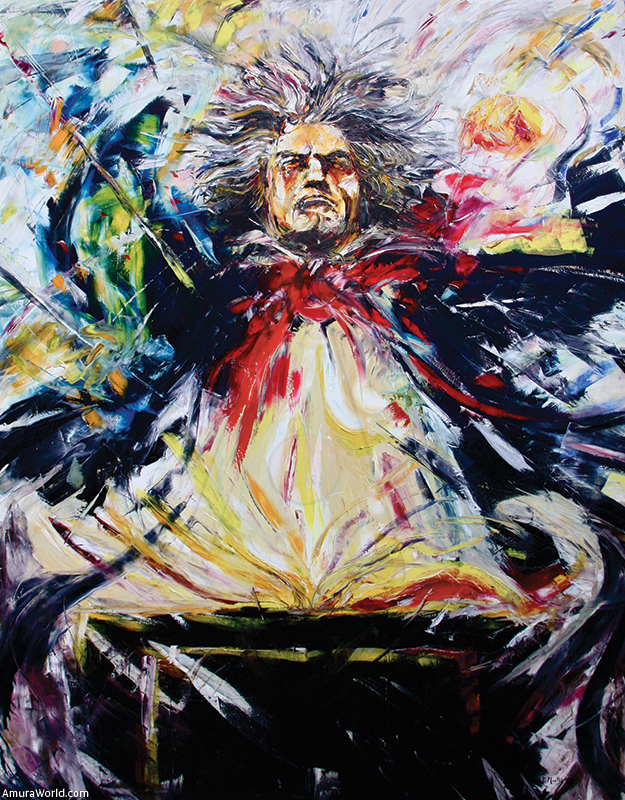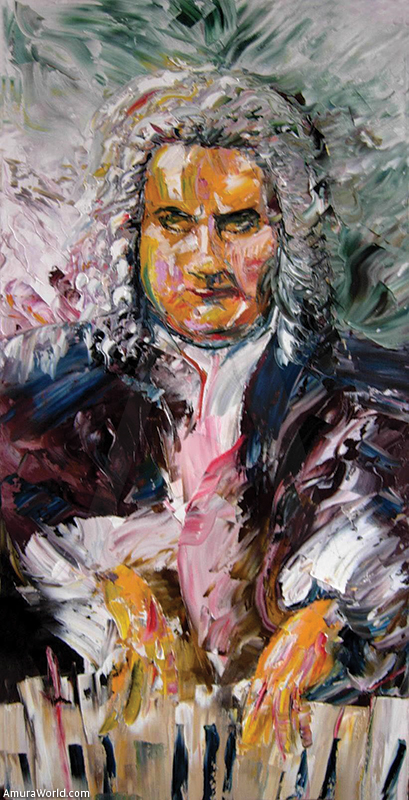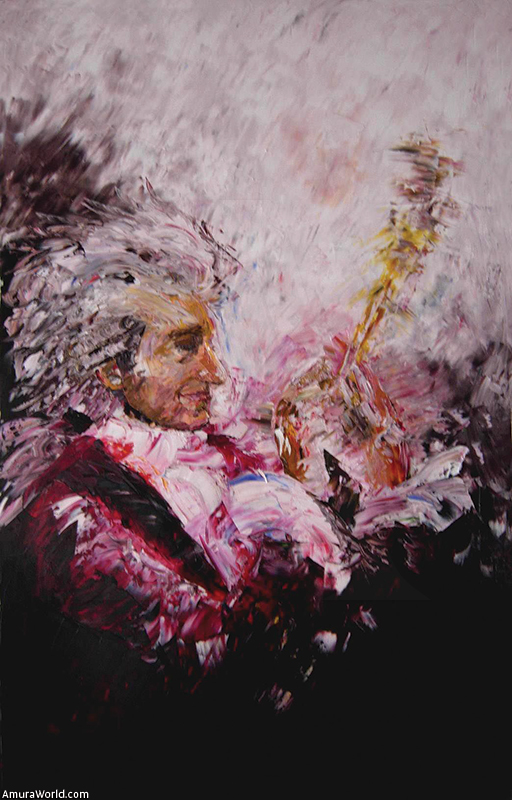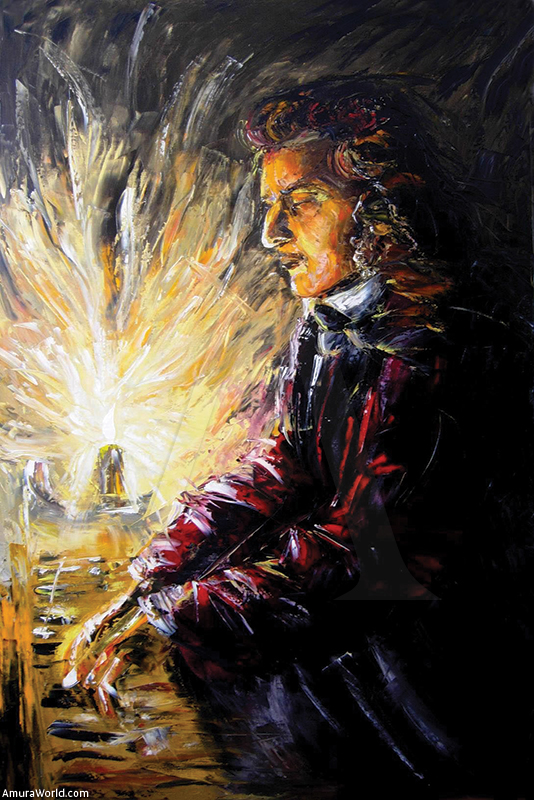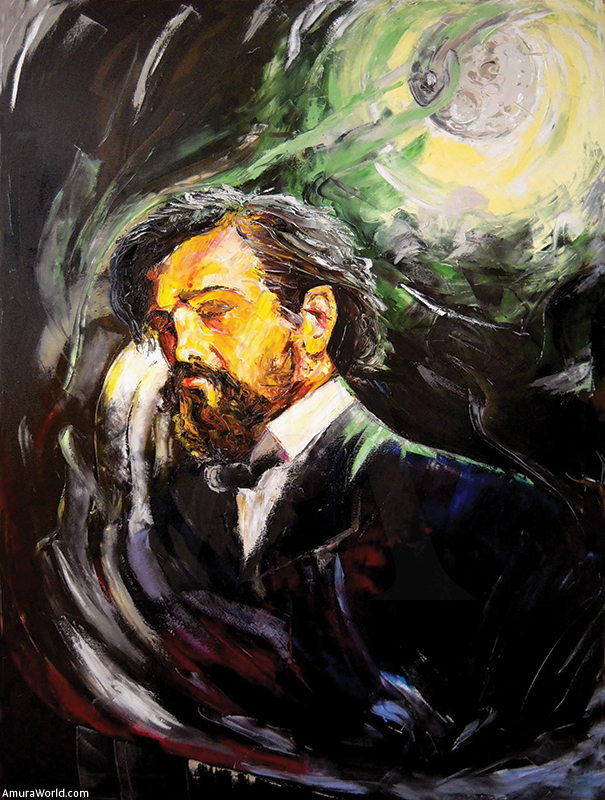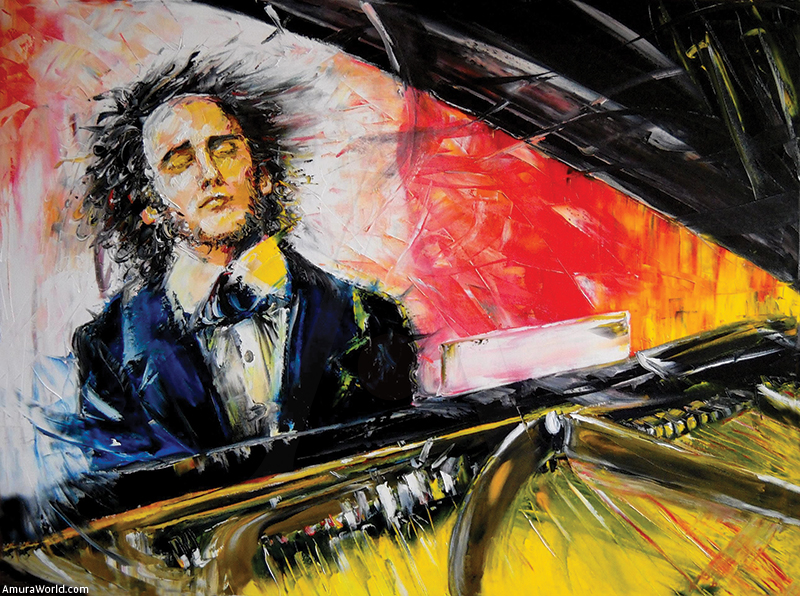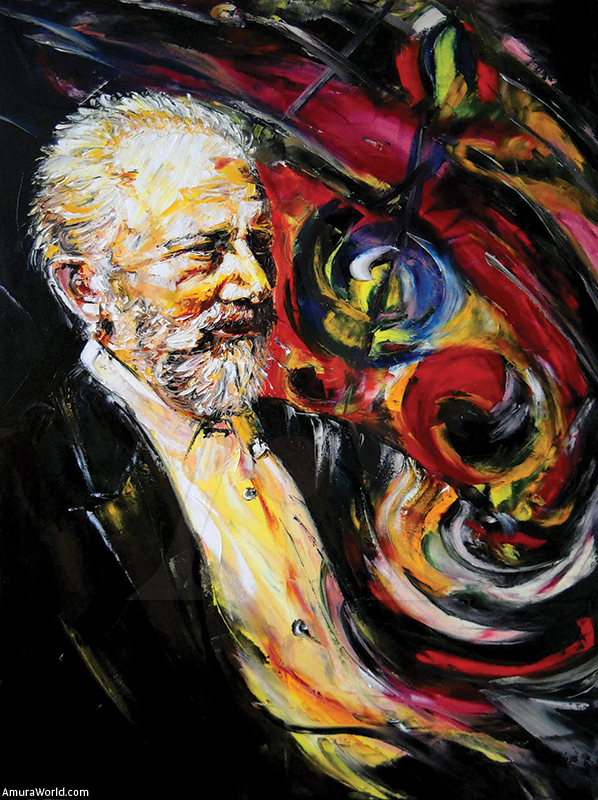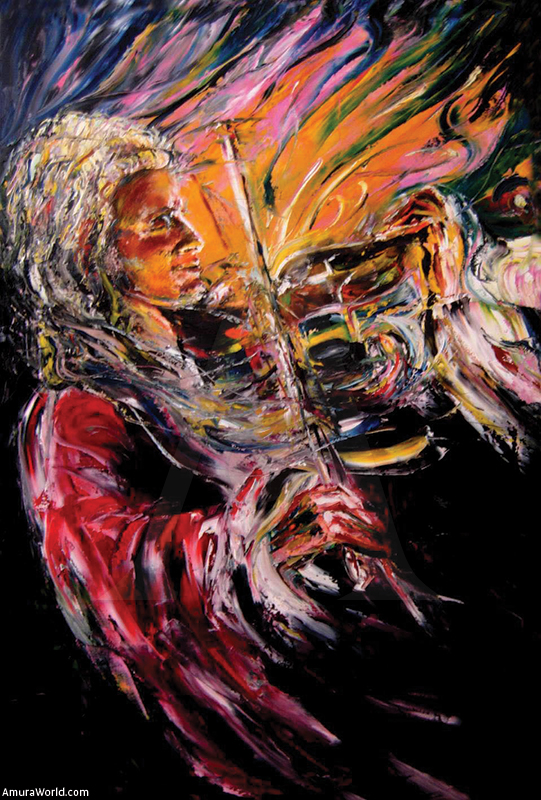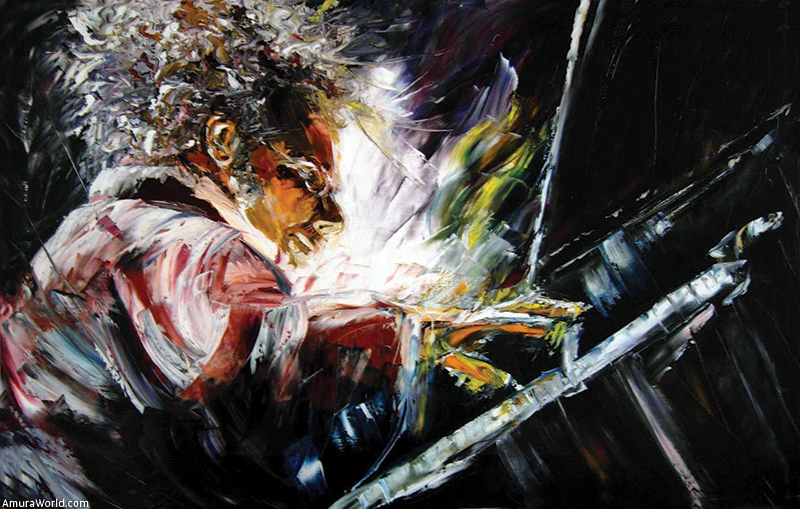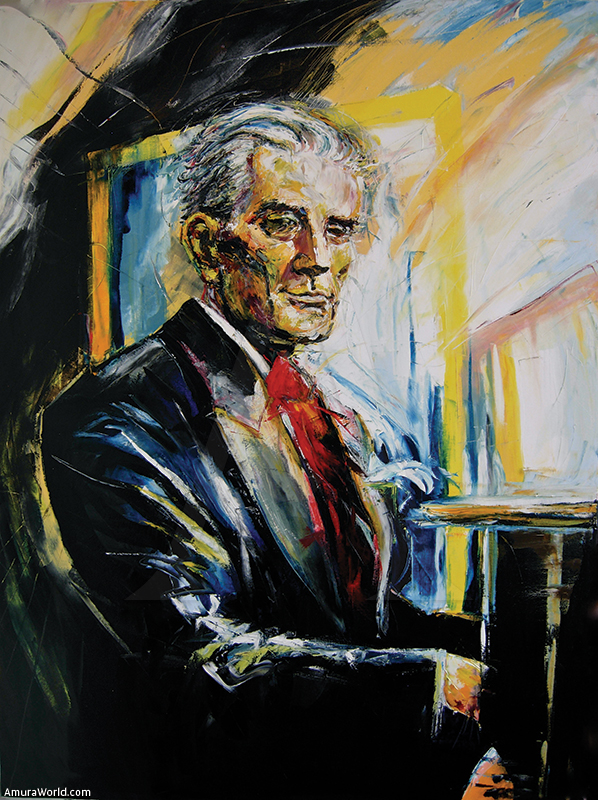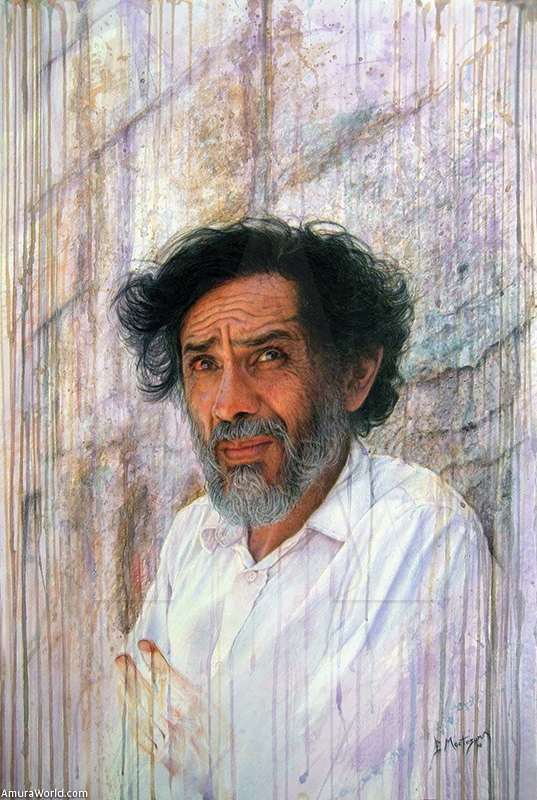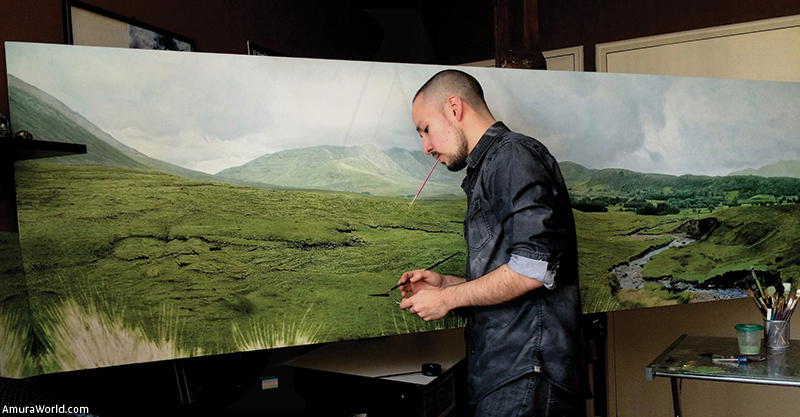“You must do what is true to you, you will be criticized and sometimes even hated, but if you maintain a high level of integrity and purpose, you will also be admired. It doesn’t matter if it’s through an exposition, books or music; one thing is certain, it won’t happen on it’s own.”
Amura Yachts & Lifestyle had the opportunity to speak with Eduardo Moctezuma, a young Mexican artists whose techniques offer us portraits full of life, realism, movement, music and imagination.
This painter began to create his artistry since a very young age due to his virtues, he talks to us about his work and inspiration, as well as a little about himself; an example of this is the reference he makes in his surrealist/hyperrealist compositions which are born from a taste in science fiction and fantasy.
“Although I have painted truly hyperrealist things and I like to do it, like an Irish landscape of three meters long which I did in a visit to Ireland, I enjoy to imagine scenes and elements that don’t exist in reality; Dalí, Chagall or Picasso did this. I think that dreams and imagination are what humans are made of, it’s what makes humanity progress and that to this day, things we are familiar with exist, things that were criticized at the beginning; artists play a very important role in this”.
The technical level that is presented gives a shocking realism in his work as a portraitist, which carries him to immortalize important businessmen and personalities, like for example, actor John Travolta. The diverse styles and techniques in which he has ventured have taken him to collaborate with writers and music groups, examples of this is the cover of the bestseller The Seventh Protector by Zozer Santana, publisher by Porrúa Hermanos, as well as several record covers.
¿How did you approach the artistic world?
This is something I already had in me, I was born with it or I inherited it from my grandmother, she was also a painter; I grew up surrounded by art. I remember one day I arrived to my grandmother’s home and found a painting drying on the easel, until this day I can remember the smell of paint. There was also a piano in that house that I loved to play. On the other hand, my dad played the guitar, he wrote a novel and he was a sculptor. My godmother played the guitar too, as well as the accordion and she sketches; with my cousins I would draw or play music. These were my first approaches to art. Today I pass the time with several artists like Edy Lan, who is one of the best composers of our time, he is a great inspiration for me. I feel incredibly lucky to have grown up in this world.
¿How did you began to paint?
Like many kids I would draw my favourite TV characters, toys, I would do compositions with them. It all began as a hobby; I had to go through several stages, the first was caricatures, after that, comics, which played an important role for me as a sketcher and illustrator, this is how I began to be a professional; In 1999, when I was 15 I worked for several magazines, amongst them Rolling Stone. Then I made storyboards for short films and music videos as well as some character designing. I always considered myself as a sketcher, not a painter, although I had experienced with diverse techniques I hadn’t done so with painting. After I studied in the San Carlos Academy, I began to paint with oil to turn myself into a painter. Under the direction of my teacher, Rocío Romero, I was ready to apply this technique into my art. What came later was a lot of practice and experimenting.
Why did you choose to paint and not other artistic expression?
Due to the fact that I saw I could do great things, express myself in a different way than with ink and pencils. Today I paint a lot, although I haven’t given up with the ink. There really isn’t a technique that I like more than the other, it all depends on what I will portray; I choose my technique based on that, lately it has been oil. Music is another great passion of mine, I play the guitar since I was 10 years old, I sing and I also love the piano. I also enjoy writing, and -although some are incomplete- I have several stories I wrote way back; I love cinematography, this took me through a phase of approaching graphic screen writing.
If I wasn’t a professional painter I would be a musician; music is an important part of my work, for example, my series of Classical Musicians, is based on some of the greatest composers of history, I created it while I was listening to pieces from great masters like Beethoven, Ravel or Paganini; I wished to “translate” the essence of each of them. In the same way pictoric creations exist based on literary works, from The Bible to novels. When the arts complement each other you can achieve great things.
Do you remember the first time you felt the need of portraying?
I don’t, but I always the need to paint, it was something quite natural for me. My parents would keep everything I sketched since I was little and I have boxes full of that, reason why it wasn’t something fortuitous. Someday I will make an exhibit with that material.
Today, when you create, where do you find your muse?
Inspiration has arrived in different forms; if we speak merely of creation, it comes from various travels, music, movies, books, women or my own feeling and ideas. When we are talking about technique and the progress in my work; I am self-taught, I learned by observing and trying to emulate the artists I admire. This is how I achieved proportions, effects, shapes, etc. I usually see the great artists as a source of inspiration. More than something unobtainable; it pushes me to improve my compositions and question myself: can I get that level of realism?
I also believe that inspiration is something you find working and when you have a clear objective toward what you wish to achieve, what you want to communicate and provoke in the spectator. What happens is that I get new ideas, especially if my objective is so vast, I don’t need inspiration from other sources.
Your work is characterized due to it’s dream-like sense or its sobriety?
I would say dream-like. I have always loved surrealism, science fiction and fantasy. I don’t feel my work characterizes as sober, it’s always accompanied by a lot of detail, be it hyperrealism or the lack of it. My next series will be loaded of it.
Could you tell us about two painters of any time period, that you admire?
One of them is Rembrandt, he is considered as one of the greatest baroque masters; his chiaroscuro has always fascinated me, no one has done it better than him. Another artist which I admire is the Austrian Gottfried Helnwein, ever since I saw his work at the San Carlos museum I was caught. Soon after, at the Albertina museum of Vienna I met him personally; on that same journey I travelled to Ireland and spend a few days at the castle where a contemporary artist lives with his family, I was in his study and saw his work up close. Gottfried has been a great inspiration, both in technique and artistry, his work possesses a perfect technique that I have never seen in another hyperrealist artist.
What pieces have created more impact on you at working on them?
My series of Classical Musicians, these were the first pieces I ever did with a spatula. This technique is pretty difficult, because of this I didn’t know what to expect, I just told myself: I’ll work (with the spatula) while I listen to Beethoven’s Ninth, let’s see what happens; the result was something I loved and this is how the series occurred. I was surprised by my capacity of transmitting feelings in a very different way as I was used to (with pencils). My first hyper realistic oil, Dreaming costs 25¢, was another great achievement and impact, in this particular surreal painting, hyper realistic elements create the scene.
How has your work developed?
By observing my surroundings, people and the work of “the greats” it has been my best school. What I do adds all my past work, from cartoons that took me to develop comics, which made me try even harder to attain a level of detail in illustration; Once I began to paint faces, I applied the same dedication and I achieved the hyperrealist portraits, I didn’t even know I was doing it. The series of Classical Musicians, is created due to the fact that I listened to classical music since my infancy, alongside the unwrapping of the spatula, which I attribute to my grandmother, due to the fact that it’s a recurring technique in her paintings.
For you, does art have an end in itself?
I see art as a higher level of communication and I believe that communication should be achieved with the intention of creating an effect, particularly an emotional impact. If as painting has made you reflect on something, or a book has changed your life, that is considered art; it’s the purpose the artist wants to portray. When a brilliant idea is accompanied by a technical, ability and passion, we are encountered with a good artist.
How do you see the artistry in Mexico?
Like all, you must persevere, be firm with your goals, work hard and with passion; we must see things from a different point of view and not from the perspective of a friend of an art critique that will try to crush you. In Mexico there are great artists and not only in painting, several people appreciate art and and is willing to pay for it.
How does this type of movement merge with new interpretations?
The current tools are pretty actual, they are the best that have existed to display art to the world. Internet is the greatest gallery of the planet, even concert halls and cinema rooms are of great utility for artists.
When it comes to painting, it will never be the same as watching the masterpiece up close; some creations have a special energy whose totality is captured by being in front of it; the truth is that internet does plays the same role as Art Books, in their time: they served the purpose to expose the artist to the world and to speak of the experience of having it in front of you, that is truly valuable. The more range you have, the better; besides, today is much more easy to contact the artists and upload them on social media.
What is next for you?
A new serie is coming, with it several exhibits, many things of the things I have done in the past will begin to take shape. I’m talking about new ideas with a clear purpose and a different estate of conscious, this is why I hope that it has great meaning for those who see it. I will seek to create an impact and inspire them. Good things are coming along as well as hard work. I have a lot of projects ahead.
Regarding the work of Moctezuma, Jorge Marín, one of the greatest exponents of contemporary figurative art in Mexico, commented: “The pictoric work of Eduardo doesn’t need any theorical frame or formal analysis -to be,beyond it’s creator-, it ventures through time, always is a solid estatement regarding its essence, which is more than universal and concrete; a tree is a tree in all it’s splendor or a glance is the human synthesis of all times. It’s worth it, to follow up close the developement of this young artist who apllies classical techniques, he channels us once again as observors of this surprising human account of re reading our surroundings with fresh eyes, it moves us to the here and now, as a faithfull witness of out resent moment”.
Currently, Eduardo moctezuma presents pieces full of life, dreams and a reality that shocks through it’s traces. They exert a control and absolute domain of technique, this is appreciated in it’s Classical Musicians, which is selected by the National Institute of the Arts to be sent into the state of Sinaloa as a permanent exhibit on the Center of Innovation and Education (CIE in spanish) of the city of Los Mochis.
As he comments, his next masterpieces will be influenced by hyerrealism and the diveristy if styles and techniques he creates. It’s interesting to see how realism grants a more simle status though the eyes of this artist, who with a mesmerizing level of detail gives elevated significates to the escences that trascend the canvas and time period.
Mozart said “Listen this young man; don’t lose sight of him, he will give something to talk about and grant astonishment to the world.”
Wolfgang Amadeus Mozart, regarding the young man of 16 years of age,
Ludwig van Beethoven, during winter 1786, in Vienna.
Text: AMURA ± Photo: Eduardo Moctezuma

